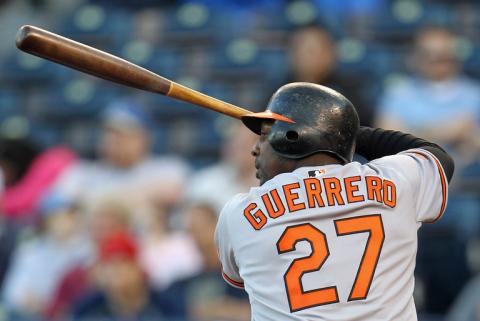For Baseball’s Hall of Fame, Do Statistics Alone Still Matter?
New York Times
January 20, 2017
by Doug Glanville
It’s a line we’ve all heard, and have probably said to our kids. It starts with “there will always be someone” and concludes with a word like “faster” or “stronger” or “prettier” or “smarter.” It’s supposed to insulate our silver-lined dream clouds with the spray foam of pragmatism. It tells us that we cannot win them all, not just because of the statistical gods, but because of the gods of creation. Some people were simply born with more talent, and they are apparently all over the earth. Humility is the lesson.
The Baseball Hall of Fame Class of 2017 inductees were announced Wednesday, and it reminded me of something I quickly learned in the major leagues: Not only is that adage still true, but that when you distill talent into distinct categories, you’ll find that the universe is crawling with people who are quantifiably superior to you.
Let’s look, first, at the players who will be inducted.
Jeff Bagwell was a quiet revolution in his own right. Compact, with huge power, but also fantastic in an all-around sense. A power hitter who stole bases, a first baseman who, before his shoulder started barking, could throw out runners trying to sneak from second to third. Steady, talented, versatile and dangerous. Oh, and just plain fun to watch.
Tim Raines’s career was winding down by the middle of mine, so my observations of his best days were from the fan perspective — Shea Stadium, Expos-Mets. There I witnessed a microcosm of his years of pure domination as the ideal offensive catalyst (and a switch-hitter on top of that). He had a career of sheer consistency, and the metrics developed in the last few years help us frame the deeper value of his statistics. He was on base all the time, and while on base, he was stealing the next one at will. For six seasons in a row, he stole over 70 bases. He rarely struck out. Contact, speed, defense, bat control.
The catcher Ivan Rodriguez, known as Pudge, was exceptional on both offense and defense. He hit for average and power to all fields. But he was equally known for his amazing arm. I tested it twice playing against him in winter ball in his native Puerto Rico. Once was in the All-Star game, when I was trying to steal third. The third baseman had the ball before I even started thinking about sliding. And once during the regular season, after I got a great jump in stealing second, I became aware of this fast-moving U.F.O. coming in that never got more than a few feet off the ground. It was as if, for my last few steps, I was running backward.
But I also marvel at the greatness of some of the players who have not gotten in … yet.
Vladimir Guerrero, for example. When you play against someone who convinces you that there are more than one of him on the field, he must be special. On defense, his long strides and powerful arm made you worry that if he unleashed a wild throw he might hit you while running the bases. On offense, he made another great player, my teammate Scott Rolen, concede, “He is so much better than I am, it is ridiculous.” One time he hit a ball so hard near our shortstop’s head that the ball was by him before he reacted. As it skipped to the wall at a blistering speed, I still hadn’t even taken my first step toward it from center field. Our shortstop aged 20 years on that play. And despite Guerrero’s free-swinging nature (he once got a hit off a pitch that bounced on its way to the plate), he was very difficult to strike out.
Trevor Hoffman pitched for the San Diego Padres as their closer for most of his career. Closers typically do not get much love from the Hall of Fame because for a long time they were seen as failed starters. That culture shifted permanently with Mariano Rivera and with Hoffman, who was known for his incredible, time-space-defying changeup. This year, I tweeted that the changeup he threw me in 1998 had just crossed home plate.
Edgar Martinez spent much of his career as a designated hitter, a tough job to stay ready for because you sit for innings at a time. He mastered the technique of hitting “inside-out” — taking a pitch that you would normally hit, say, to the left side of the field and carving it to the right. This made him unpredictable and forced your defense to spread out more, which created safe havens for his line drives. He could hit foul line to foul line, prompting my old teammate Mark Grace to warn our pitcher during a spring training game: “Save yourself a pitch. Just throw the ball down the right-field line.”
These players, and many others, I expect to be in the Hall of Fame within the next few years. They certainly were examples of the players who left an indelible mark in my memory simply by how much they stood out from among their competition.
I had a respectable major league résumé. I may not have evoked Hall of Fame numbers, but I certainly had a few days in the sun. But I understood early in my career that, in spite of my high school and college legacy as a middle-of-the-order hitter, I was going to have to be a top defender, good decision maker and speed guy — at the top or bottom of the order — if I was going to survive in the big leagues for more than a moment. I didn’t worry too much that someone might have bigger numbers. Your true value came through how you used, understood and sharpened the tools in your toolbox.
Maybe that is why our obsession with (and debate over) baseball statistics is timeless and also endless. I saw the pitfalls of putting heavy emphasis only on what you can compile. You risk overlooking players whose contributions cannot be quantified. Also, the distortion caused by the era of performance-enhancing drugs morphed what were once gold-standard metrics into something irreconcilable. We can no longer draw a hard line as a milestone of greatness — 500 home runs, 300 wins and so on. The once-dependable math got fuzzy.
The opportunity here is that we can now look for meaning within these numbers, and not just count — even if this embroils the debate over difficult-to-define terms like “character” as requirements for Hall of Fame entry. This is a healthy direction to go, given that what stays in our souls from watching these players over time is a feeling, a moment, a memory that is often independent of math, even when we can recite the stat line of that player’s career. The scouting report fades, the lefty-righty splits are irrelevant, the weakness to his backhand side unimportant. Greatness is now the summation of your work.
These players separate themselves from the pack through consistent excellence and longevity: the hallmark of a Hall of Famer.
One of baseball’s challenges in the next decade of Hall of Fame voting will be to face the demons of the steroid era, the idea that some of this greatness we celebrate may have been purchased or artificially enhanced. It will make us wonder what defines the “better” that our parents were always talking about.
So maybe “better” needs an asterisk, like the one suggested to frame the steroid era: one that notes that it is hard to learn humility by taking shortcuts to greatness. We will never know the full story of anyone who played in the steroid era, what they did or did not do, and that makes it unfair to indict an entire generation of baseball players. But at least we can challenge our kids not to trust their eyes — and to look deeper, beyond the numbers, for meaning.
Republished from The New York Times
Photo: Vladimir Guerrero, the not-yet-Hall-of-Famer, in 2011.
Photo Credit: Jamie Squire/Getty Images






